13 Jan 2025
Feel free get in touch with us via email or social media.
© UEA. All rights reserved. University of East Anglia, Norwich Research Park, Norwich, Norfolk, NR4 7TJ, UK
Engagement Strategies for Rural and Coastal Communities in North Norfolk

Written by Kristen Jones, Advanced Public Health Officer – Place & Community, Norfolk County Council
About the author
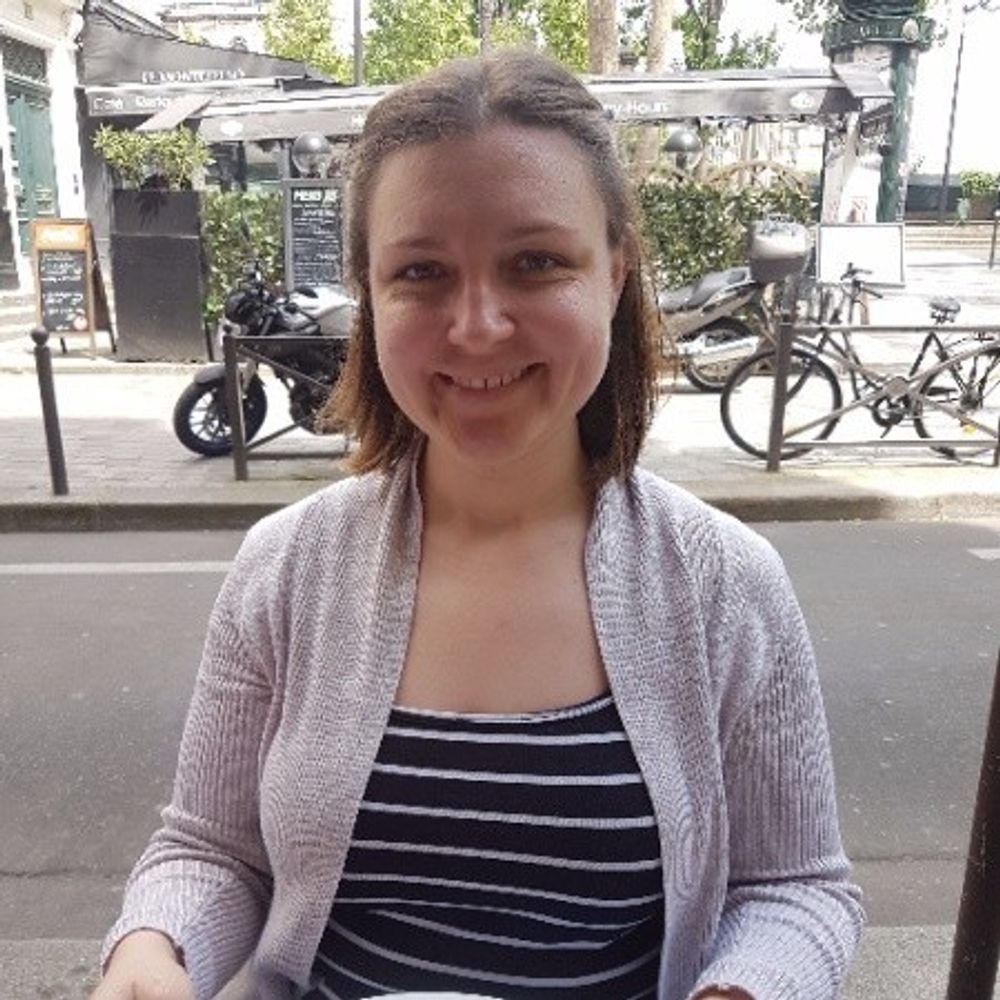
I am an Advanced Public Health Officer at Norfolk County Council and am the place lead for North Norfolk. I am also an experienced project manager, with both PRINCE2 and AgilePM Practitioner qualifications. Within the RIPPLE project, I acted as Project Manager, chaired the Project Board meetings, and coordinated the delivery of the project and its engagement strategy. I live and work in North Norfolk and used my local knowledge to tailor the engagement strategy to meet the needs of the local population to ensure we had a range of participants from the study area to conduct robust research.
The project: RIPPLE – Improving Climate Psychological Preparedness for Coastal Communities
The RIPPLE project – short for ‘ImpRoving ClImate Psychological Preparedness for CoastaL CommunitiEs’ – worked alongside existing coastal resilience, coastal management, local authority partners, and communities, to better understand the potential mental health impacts of climate-related risks such as flooding and coastal erosion in coastal populations. The project also developed prevention methods for addressing these. The two study areas selected were Mundesley and Walcott civil parishes.
The places: Mundesley and Walcott
Mundesley and Walcott civil parishes are situated on the northeast Norfolk coast, and sit between Cromer and Great Yarmouth, within the North Norfolk district.
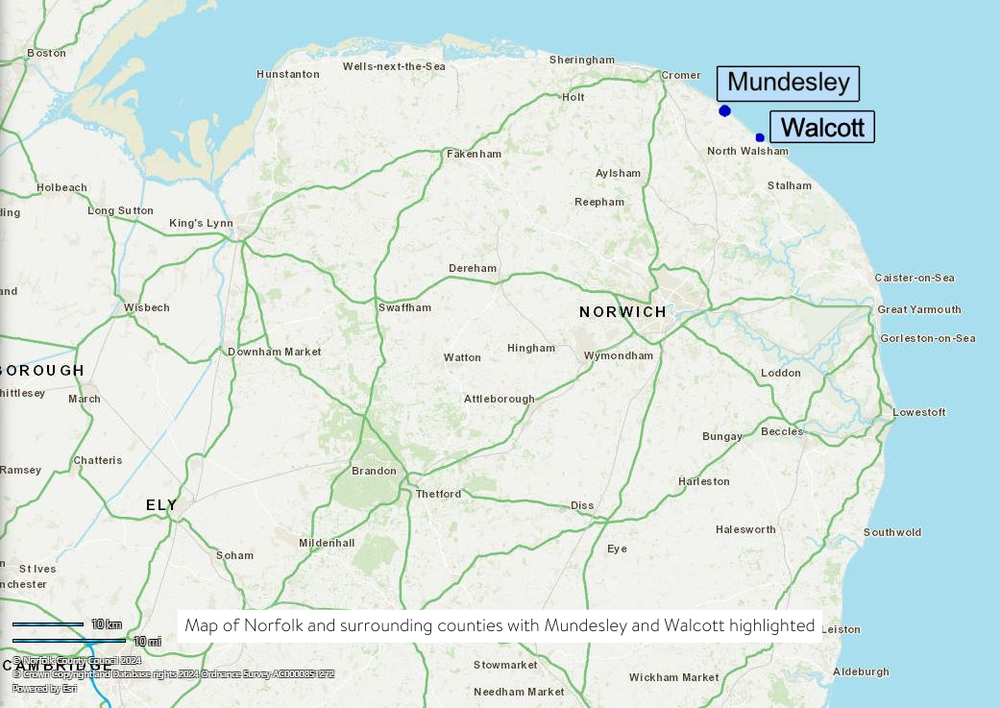
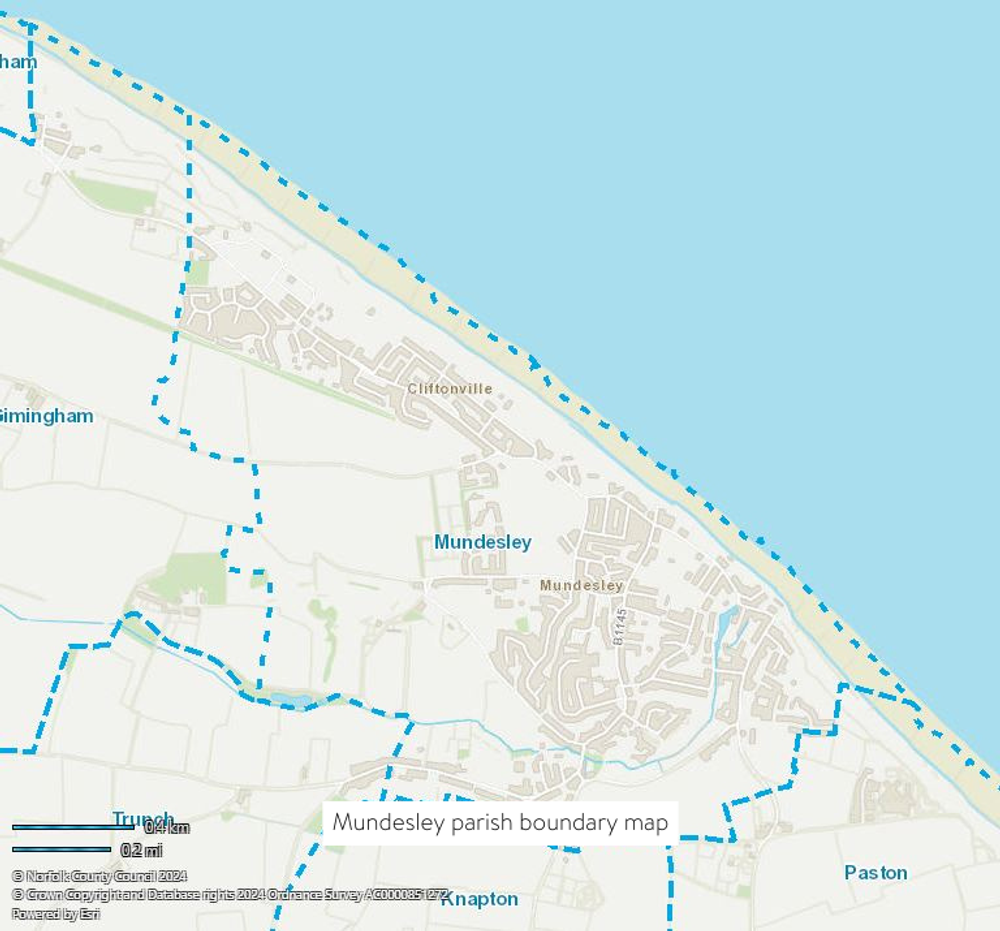
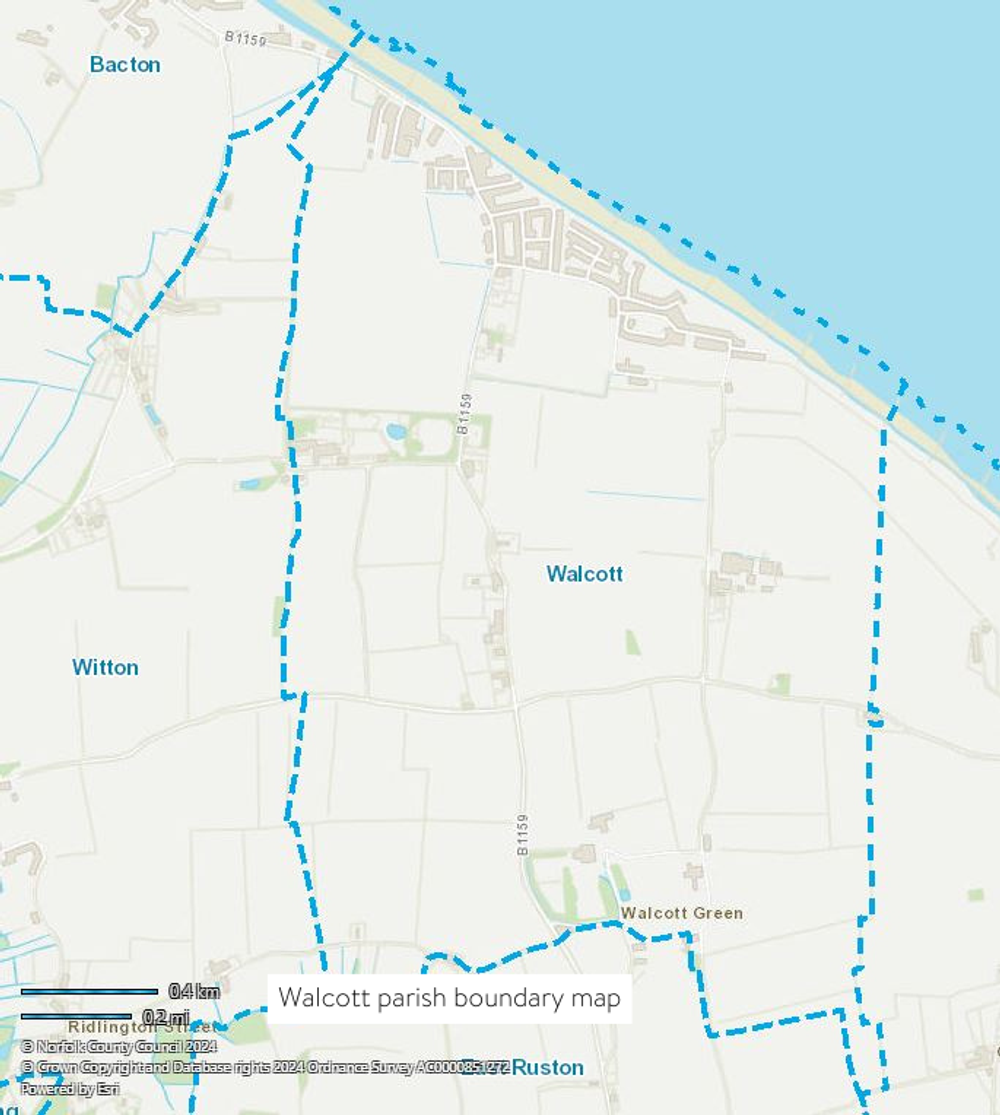
These parishes are both rural and coastal and have limited access to public transport and services. While isolated, these areas have incredible natural beauty and access to the environment – something that was raised by residents throughout the research as a key reason for living in these areas.
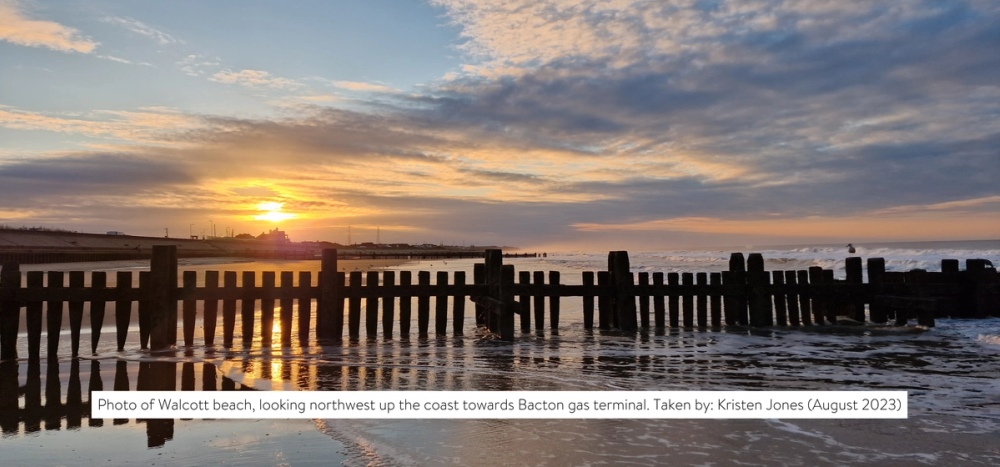
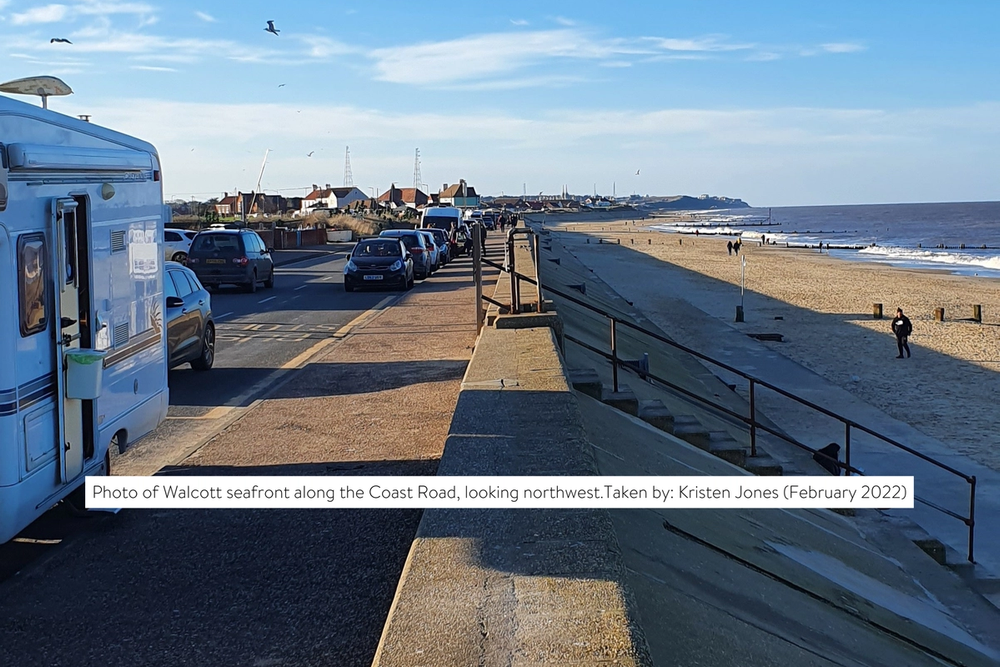
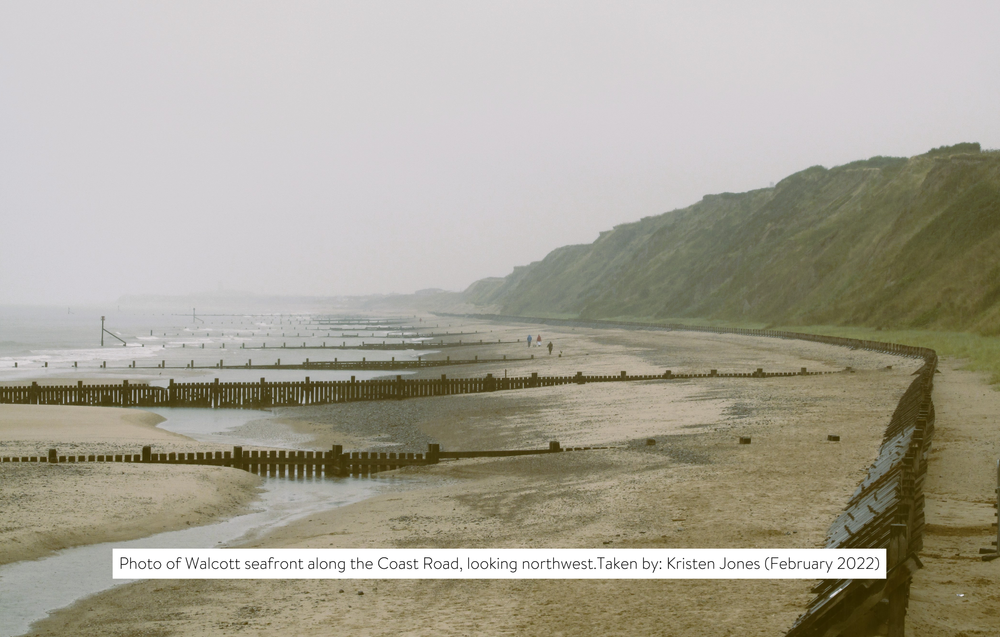
These places were chosen as the study areas because they are two communities both at-risk of future coastal erosion and flooding, but which are diverse in terms of size and infrastructure. Mundesley is a larger village with more infrastructure and services, while Walcott is a small village with fewer amenities. In addition, both are relatively under-researched compared to other areas of the Norfolk coast, such as Happisburgh and Hemsby.
The people
According to the 2021 census, Mundesley is home to 2,778 residents (making up approximately 1,760 residential properties and 1,383 households), while Walcott has around 630 residents (approximately 450 residential properties and 327 households).
North Norfolk district has the highest average age in England and Wales according to the 2021 Census, and the older age groups in this area are predicted to grow in future. In line with this, Mundesley and Walcott have a high number of over-65s. Nearly 40% of Mundesley’s residents and nearly 37% of Walcott’s residents are over 65 years of age, compared to 18.4% in England and 24.4% in Norfolk.
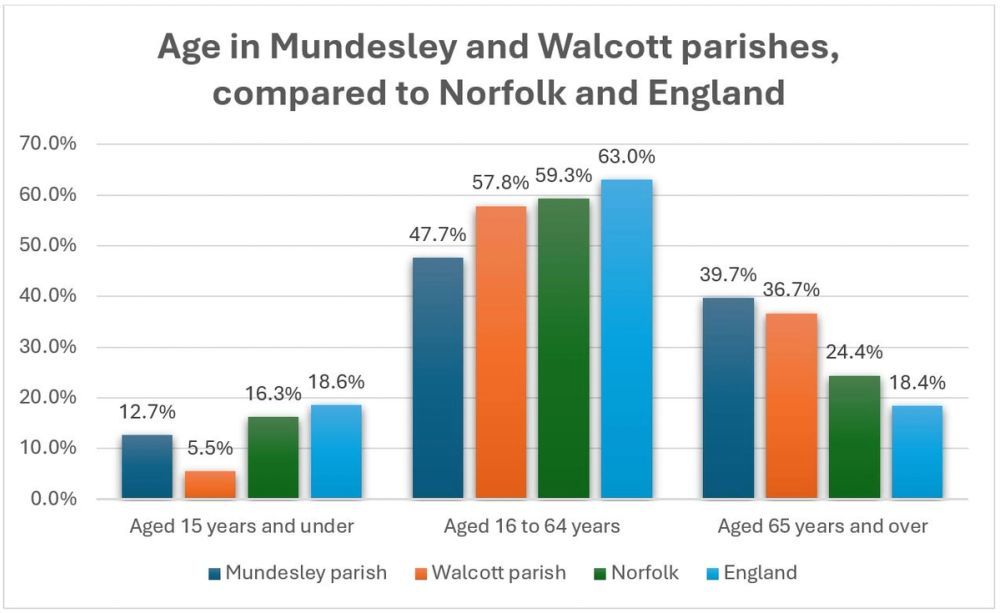
Both areas experience deprivation. One of Mundesley’s two Lower Super Output Areas (LSOAs) is identified as part of the Indices of Multiple Deprivation (IMD) decile 3, meaning that the population is within the 30% most deprived nationally. Walcott also sits within an LSOA which is IMD decile 3. In short, households in Mundesley and Walcott parishes are rated as relatively deprived compared to other households in England.
Digital exclusion is a big challenge for these parishes. According to the Index of Digital Exclusion for Norfolk and Waveney (1), one LSOA within Mundesley parish falls within decile 2, meaning that it is within the 20% most at risk for digital exclusion within Norfolk and Waveney. Walcott is within an LSOA which is within the 10% most at risk for digital exclusion within Norfolk and Waveney. Both areas are circled in the map from North Norfolk district below. In short, households in Mundesley and Walcott are a high risk of being digitally excluded.
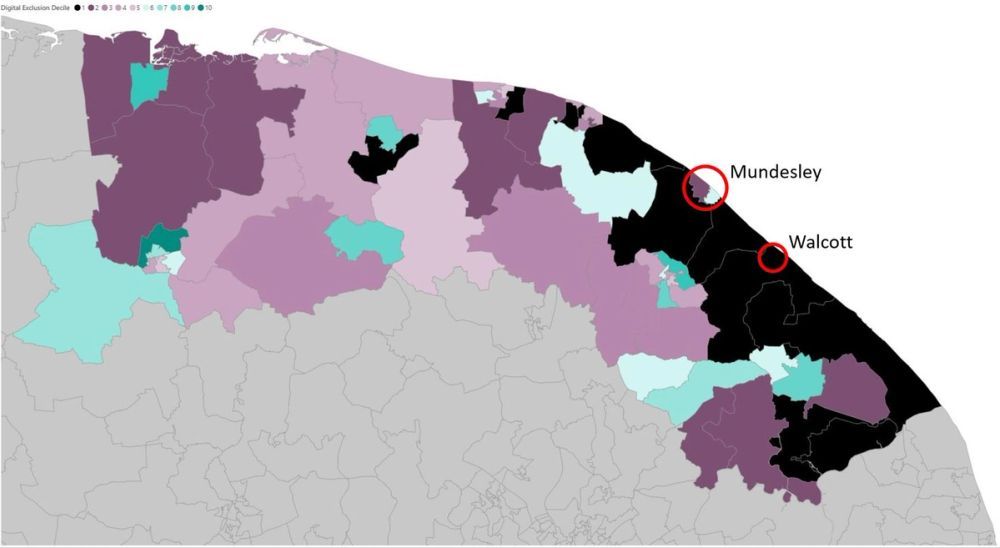
Norfolk & Waveney Digital Exclusion Heatmap – map of North Norfolk LSOAs
Some of the demographics of Mundesley and Walcott mean that these areas have a higher risk that their residents are digitally excluded, including a larger proportion of older people, people in lower income groups, and people living in rural areas. Many residents may not have internet access at home, cannot afford internet access or devices, do not have the skills to easily access information online, do not have the confidence, or lack motivation because they don’t see why getting online is relevant or helpful. Even if these groups are online, they may not be engaged on social media and therefore our project would be unable to reach them in this way. Therefore, engaging with these residents needed to be done in a way that is accessible for them.
The process
The data for this research project was gathered through two methods:
- quantitative community surveys, which assessed psychological preparedness for climate change risk. The survey was available online or in hard copy from many local venues including the local library in Mundesley, mobile library van in Walcott, local cafes and shops, the Post Office, the food larder and community fridge, and from community groups. We offered entrance into a prize draw for one of three £50 gift vouchers as an incentive (2); and
- in-depth qualitative semi-structured interviews with individuals who volunteered to participate at in-person at a local venue of their choice or at their home, or online if they preferred. To get involved, participants completed an Expression of Interest (EoI) form, which was available online and accessible in hard copy (from the same locations as the survey). Participants were subsequently contacted by the researchers to arrange their interview. Everyone who participated was offered a £20 gift voucher as an incentive.
The partners
Throughout the project, many partners were involved including:
- Norfolk Public Health, who led and managed the project.
- Norfolk and Suffolk Foundation Trust (NSFT), who led the research approach and data collection – both quantitative and qualitative elements.
- North Norfolk District Council’s Community Connectors team, who are the trusted communicators who supported the engagement of several local established community groups as well as being present at many of the semi-structured interviews with residents. The Community Connectors team also run regular PositiviTea events around the district as well as hosting a regular show on Poppyland Radio to support improved health and wellbeing outcomes by connecting people with the support services and social activities that could benefit them.
- North Norfolk District Council’s Coastwise team, who provided guidance and insight from their project, which is part of the Coastal Transition Accelerator Programme (CTAP). They hold Coastwise Cafes to engage with the public and helped our project by sharing their insights on how they have supported coastal communities to transition and prepare for changes.
- Norfolk and Waveney Integrated Care Board’s Community Voices team, who enabled the process of feeding back the qualitative data from the semi-structured interviews into the Integrated Care System’s (ICS) Community Voices Knowledge Bank.
Promotion of the project and recruitment of participants
A central challenge for the project was making this survey and semi-structured interviews accessible to all sectors of the community, but only within the study areas. The study areas were geographically small, and we took great care to ensure that the project and ways to get involved were promoted to exactly the relevant population. Early on we realised that using typical Norfolk County Council communication channels would not be suitable because the information would be distributed to a much wider audience than needed. Doing so may have led to disappointment for individuals outside of the study area.
Therefore, we worked with the local communities, organisations, local councillors, and individual Community Connectors to identify how to promote the project and engage with residents within the study areas. The engagement strategy was therefore much more localised than in other projects. I attended the Annual General Meeting of Mundesley Parish Council and made direct links with the parish council and local organisations who agreed to distribute the information. I also engaged directly with local district councillors and relevant county councillors to gain their support for the project and to help with outreach. The Community Connectors and I identified local groups which met regularly in the study areas and the Community Connectors attended several local events to support the completion of the survey and EoI forms.
After reviewing the data around digital exclusion, and consulting with residents and councillors, it was clear that a significant amount of local communication was carried out via word of mouth, physical posters, and hard copy leaflets. This was particularly true in Walcott. As described above, the survey and EoI form were available online, but crucially, we provided hard copies as well which could be collected from many local venues such as the library. Hard copies included a Freepost address to reduce the barrier of postage costs in returning them.
Our project utilised a landing page on the Norfolk County Council website which included key information about the project and the research aims, details of engagement events, and links to complete the online-versions of the survey and Expression of Interest form. This landing page was hidden and not navigable from the main www.norfolk.gov.uk website, and rather, was promoted only on leaflets and social media posts about the RIPPLE project.
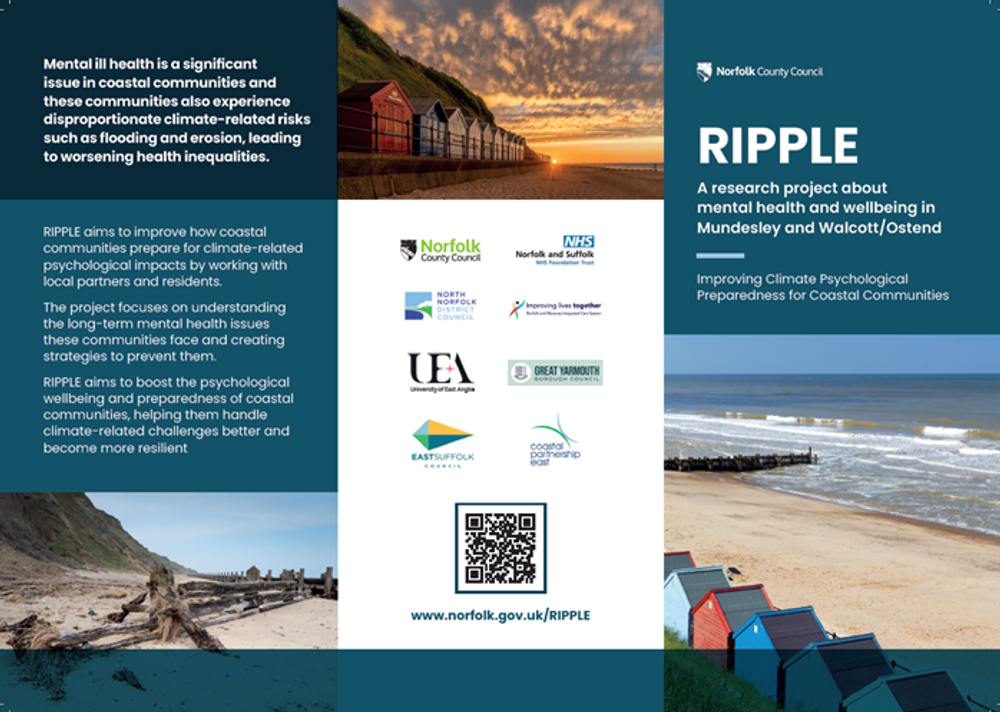
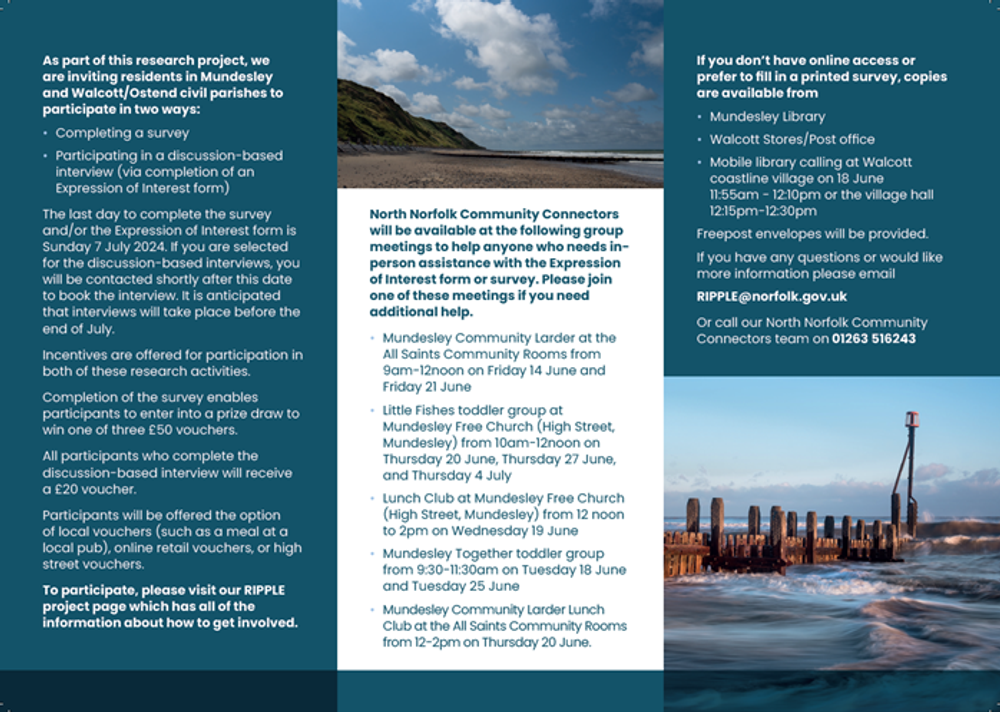
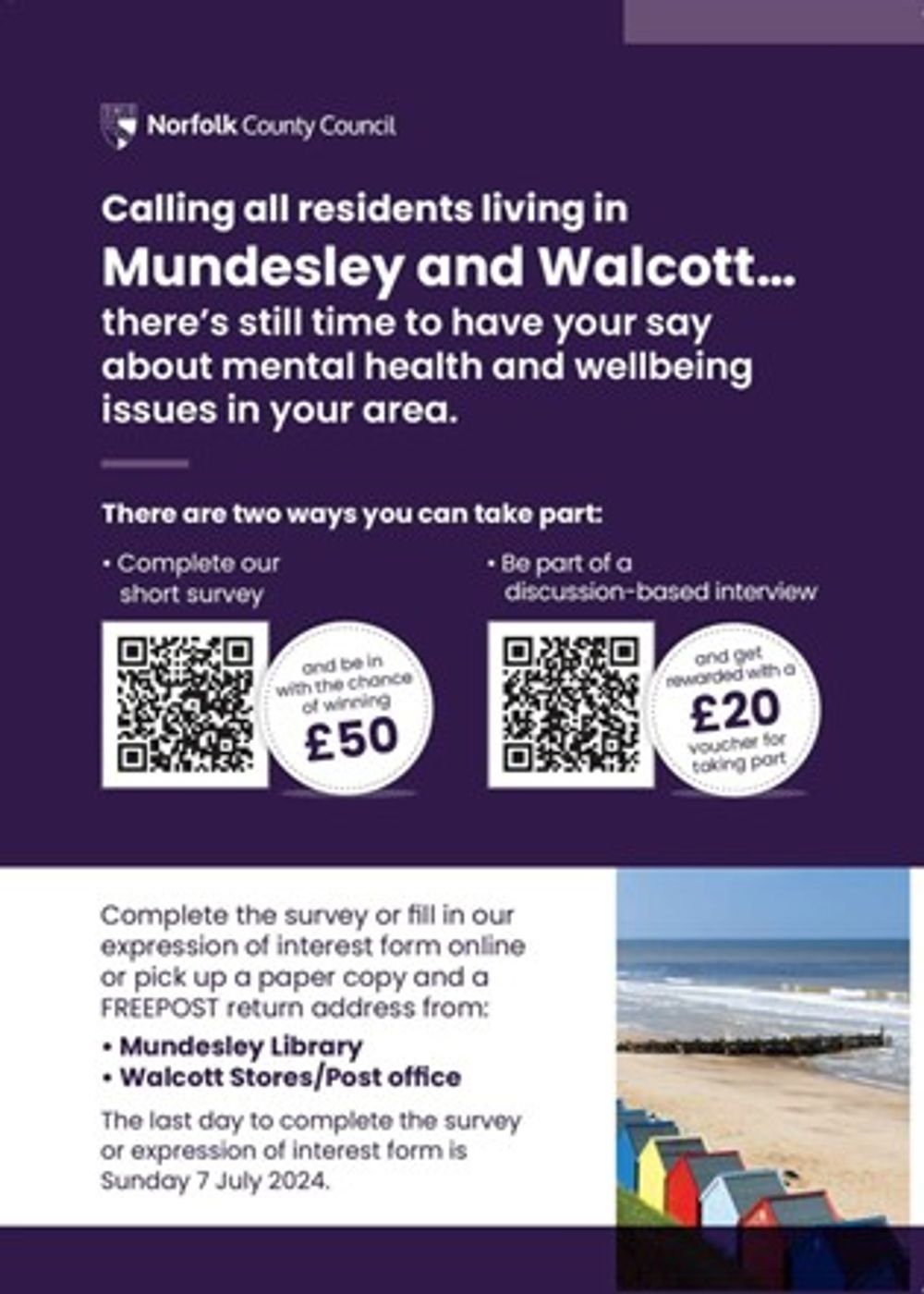
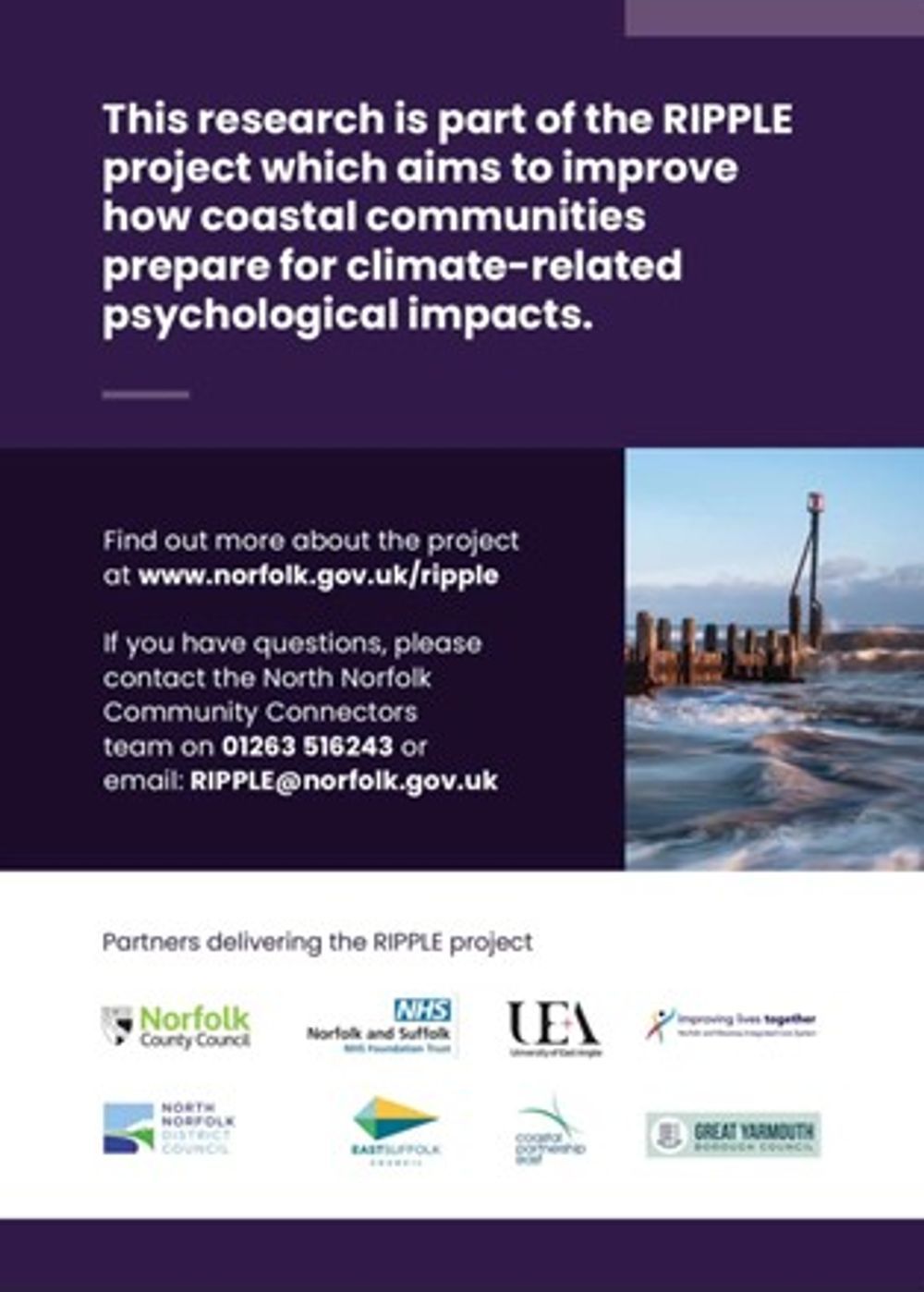
Norfolk County Council Communications team developed two different leaflets for the project. These were distributed at all the previously described local venues and events. Crucially, we also used a hand-delivery service and Royal Mail to ensure the leaflets were distributed to each residential property in the study area.
First, the tri-sectional leaflet was hand-delivered by a distribution company to each residential property over three days during the week of Monday 10 June 2024 and received 22 survey responses and 9 Expression of Interest responses, fewer than we had hoped to receive. We then undertook extensive promotion on local Facebook groups and NextDoor communities and we were supported in this by the local district councillor for Mundesley as well as the administrator of a Walcott Facebook group. The local parish councils also promoted the project through their social media accounts and websites.
This project unfortunately coincided with the 2024 UK General Election campaign which brought some additional challenges to our engagement strategy. Election Day was on Thursday 4 July and residents may have missed our leaflet in amongst others they received through their letterbox. Therefore, on Monday 24 June, we re-sent the tri-sectional leaflet via Royal Mail 2nd Class post, each addressed to ‘The Occupant of’ followed by their personal address. The leaflet was sent within a franked envelope branded with ‘Norfolk County Council – Public Health’ on the bottom right corner, hoping to distinguish it from other leaflets and boost engagement. We sent out the A5 leaflet between the 3rd to 5th of July which was delivered to every property via the distribution company. Support from local district and county councillors may have also been affected by the elections’ timing, due to capacity issues.
The response
We had a successful level of response for both the survey and the Expression of Interest forms, enabling for meaningful and scientifically sound outcomes on which to base recommendations. A total of 52 responses were received (41 from Mundesley and 11 from Walcott). A total of 14 EoI responses were received (11 from Mundesley and 3 from Walcott). There was a total of 10 interviews conducted – 8 with Mundesley residents and 2 from Walcott.
Out of 8 Mundesley interviews:
- 3 were carried out via video call,
- 1 was carried out over the telephone, and
- 4 were carried out in-person
Out of the 2 Walcott interviews:
- 1 was carried out via video call, and
- 1 was carried out in-person
Reflections and recommendations for future primary research with rural and coastal communities
Looking back at the delivery of the RIPPLE project, I was able to use my local knowledge of the place where I live and work and my connections to the community and local organisations to make this project a success. There are unique challenges when engaging with rural and coastal communities and I feel that these challenges were addressed adequately and appropriately.
A key recommendation for carrying out similar work would be to make local connections and to link with those who know the area best. Local councillors are a great asset and can give you very rich intelligence on how to achieve the best levels of engagement. Co-design the project with residents and organisations from your study area, and with researchers who also know the area well. Working alongside key people in the community and other organisations that have close links, gave them the opportunity to shape the delivery and to directly contribute to its delivery.
As always, don’t forget to address ethics issues. Working closely with a Senior Analyst within Norfolk’s Office of Data and Analytics (NODA) we ensured that all ethical considerations were thought through. This linked to the development of a comprehensive and detailed Information Sharing and Data Processor Agreement to ensure that the project was General Data Protection Regulation (GDPR) compliant, and all parties were happy to sign the agreement. This part of any project always takes longer than expected so make sure you factor this time into your project.
Be sure to budget appropriately for design, printing, postage, and distribution costs. I’d recommend working out the number of residential properties early on (using something like the Ordinance Survey’s AddressBase PLUS data, for example). Factor in direct mailing costs to the number of residential properties in the study area, based on current 1st and 2nd class postage prices.
Overall, this project has been extremely rewarding. I believe the recommendations which evolved from it will help these and similar communities in the future to develop ways of supporting the mental health of communities affected by the impacts of climate change.
Appendixes
(1) The Index of Digital Exclusion for Norfolk and Waveney brings together data from many sources, including the Indices of Multiple Deprivation, the Office of National Statistics (ONS), the Office of Communications (Ofcom), and NHS Digital.
(2) Incentive gift vouchers were made available to participants as set out above.Participants could choose the appropriate value gift voucher in the form of Amazon voucher, high street shopping vouchers, or gift voucher for a local pub Sunday lunch.Not everyone who was offered an incentive took it up, but all participants who did, opted for Amazon vouchers.
Age in Mundsley and Walcott parishes, compared to Norfolk and England data from Census 2021
A5 leaflet produced for RIPPLE project
Related News & Events
No results, please try changing the filters
Stay up to date
Subscribe to our newsletter to receive news on the latest updates and projects in health and social care research.